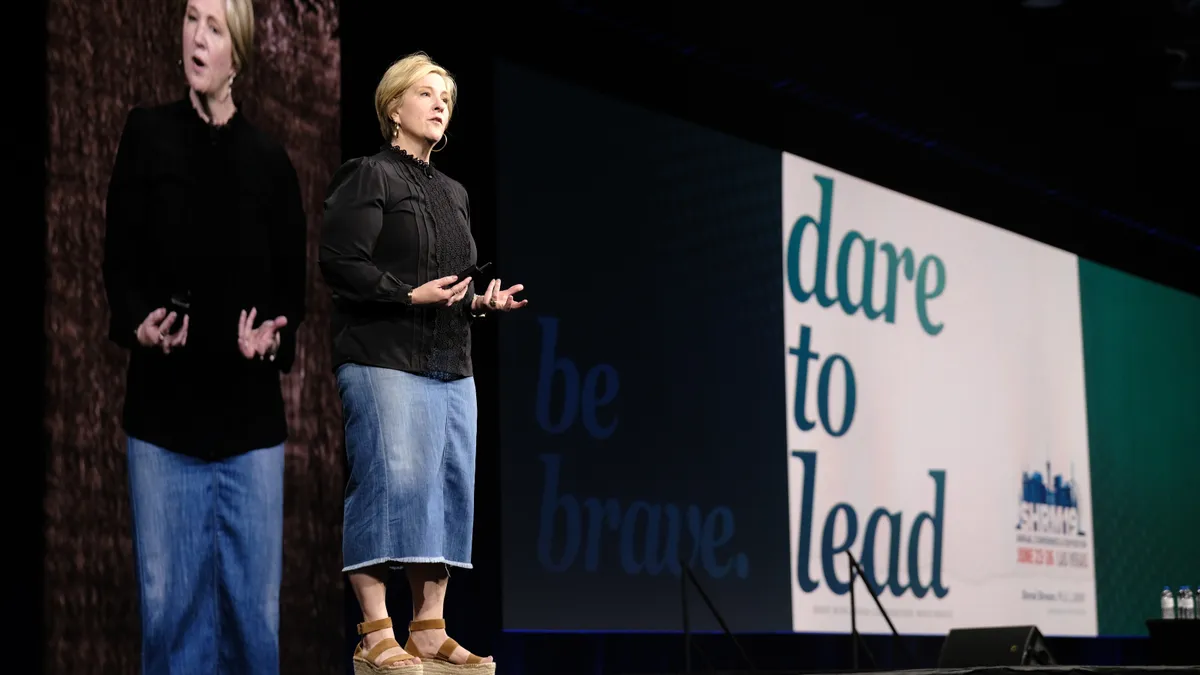LAS VEGAS — Many employers have value lists, but few managers know how those values translate into action — making those lists next to worthless, Brené Brown, speaker and researcher at the University of Houston, told HR managers last week during a general session at the 2019 Society for Human Resource Management Annual Conference.
Brown had one answer for how HR, strapped for time and resources, can make the workplace better: brave leadership.
"We asked leaders all over. What is the future of leadership? Who will be standing in five years? Who won't be? And for the first time in my career, the answer was saturated across everyone I interviewed: We need braver leaders. We need people who can make change and rehumanize work," Brown said.
Brown said her research subjects had trouble defining "what makes up a brave leader?" Instead, she asked: What does the absence of brave leadership look like?
Not having tough conversations
Not enough challenging conversations take place, generally, Brown said. Corrective conversations (the typical tough conversation) usually aren't fun, but in avoiding them, managers choose a worse alternative and talk about those who have done wrong, rather than to them.
This can allow the problem to fester unabated.
HR practitioners should remember that asking managers to have hard conversations is like asking an airline passenger to fly the plane based on their number of frequent flier miles, Brown added. The manager may not inherently have the tools to do the task; but HR can enable the development of those skills.
Not embracing fear and feelings
Brown called this missing skill "the worst one on the list" due to its inherent difficulty.
HR leaders tend to spend "an unreasonable amount of time" dealing with people's fears and thus end up "playing whack-a-mole" with unproductive behaviors triggered by those fears.
A leader has to be okay probing the fears and insecurities that may underpin behaviors, but it can take serious time — and emotional engagement — to do so.
Getting stuck in setbacks
Failure is necessary for innovation, but if leaders want to embrace failure as a cultural norm, they need to model for their people how that may look.
"We spend 20% of our energy fixing it and 80% helping pull people out of 'the shame s---storm,'" Brown said. "People have to be responsible for their own bounce."
That bounce — usually referred to more broadly as resilience — can be taught, but timing is key; you can't teach people to get back up from a failure "when they are on the ground," Brown said. Education on resilience and bravery, as Brown called it, needs to start during onboarding.
Falling for action bias
People want to fix problems, but defaulting to action before strategizing about the issue can lead to solving the same problem over and over again.
Proper problem identification often requires someone "to sit in vulnerability" to discover what really went wrong, Brown said. That process can be painful, but it is often necessary to solve underlying issues once and for all.
Ignoring inclusivity, diversity and equity
Brown said that HR leaders have a responsibility to build a more inclusive workplace. "If you can't have those conversations because they make you uncomfortable, you will not be leading in five years. Period," Brown said.
If a leader opts not to talk about hard things because they aren't affected by those issues personally, they are using their privilege as a shield, she added; brave leaders are never quiet about hard things.
Additionally, "it is not the job of the person targeted by discrimination to lead the conversation," she said. Leaders have to lead.
Using shame and blame
Abrasive management will eventually drive people to disengage to stay psychologically safe, Brown said.
Backchanneling work (having meetings, only to actually discuss the issue outside of the meeting) and weaponizing fear will corrode trust in the long-run; if a manager walks through the organization and actually sees people belittling each other, "you have a crisis on your hands," Brown added.
That behavior needs to be shut down immediately, and culture should be built not to enable it in the first place.
How 'armor' blocks leadership
"Armor protects our hearts," Brown said, and it perpetuates itself.
Perfectionism, struggling with scarcity ("I don't have enough time," "I'm not good enough."), feeling as though you aren't allowed to be wrong, leaning on cynicism and hustling for worth (always wanting to be seen as the contributor) are all ways that a leader can cripple their attempts to lead, she said.
Taking off that armor requires courage, but luckily, "courage is teachable, observable and measurable," Brown said. When she first started her research project on courage, her original hypothesis was that the biggest issue would be getting over fear.
"But it's not fear that gets in the way," she said. "It's armor. It's what we do to self-protect when we are afraid. We are all afraid and brave at the same time every day."
The best leaders understand that — and through that understanding, enable the workers around them to achieve their best potential.
























